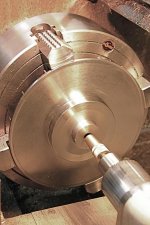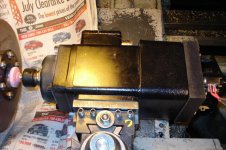RDL
Stainless
- Joined
- Jun 5, 2005
- Location
- Edmonton,Alberta,
Before going any further I thought that it might be a good time to get the technique "calibrated" on the forum. I have not lapped a taper before therefore I can only imagine what is required - which is not the same as having experience. The first iteration Lap was solid to the Tailstock but the Internet advice was to have a sensitive feed. Pictured below is the modified version which has a 3/8" guide on which the reamed Lap slides. The feed is finger controlled - well that is the plan. There are three laps for various grit sizes.

The Impeller taper is cut using the same 4° Taper Attachment settings as used for the Lap.

The center hole was drilled under size then opened with a small Boring Bar. The next step is to use the Taper Attachment to machine the proper internal taper.
Usually Lapping is done after grinding so I do not know what to expect if it follows a FF insert. I've tried grinding which was good, but not so good (I used the Compound instead of the Taper Attachment). FYI the Lap, pictured above, has a turned finish. Lapping speed is estimated to be about 200 RPM and sprayed with Varsol or WD40
I have the following Lap Grits 90x - 280x - 400x - 600x and several diamond pastes which I don't think will be required.
Suggestions or Flames ?
Raymond

The Impeller taper is cut using the same 4° Taper Attachment settings as used for the Lap.

The center hole was drilled under size then opened with a small Boring Bar. The next step is to use the Taper Attachment to machine the proper internal taper.
Usually Lapping is done after grinding so I do not know what to expect if it follows a FF insert. I've tried grinding which was good, but not so good (I used the Compound instead of the Taper Attachment). FYI the Lap, pictured above, has a turned finish. Lapping speed is estimated to be about 200 RPM and sprayed with Varsol or WD40
I have the following Lap Grits 90x - 280x - 400x - 600x and several diamond pastes which I don't think will be required.
Suggestions or Flames ?
Raymond



